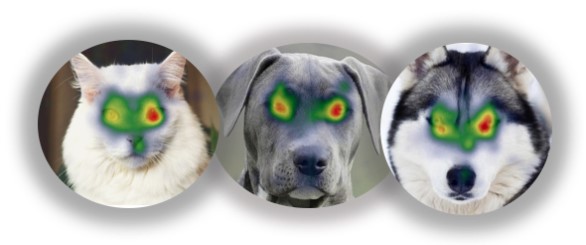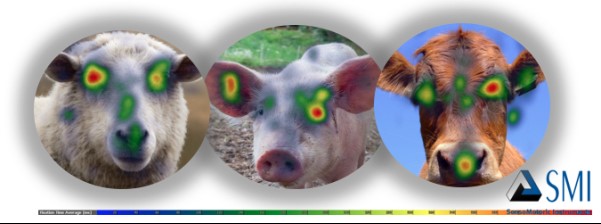Veganism is a lifestyle rooted in compassion, our drive to act on another’s behalf, in order to alleviate their suffering. Foundational to compassion is empathy, the capacity to recognise and share the feelings of another, as if they were our own. Therefore, in order to show compassion, we must first experience empathy. But, what exactly does empathy look like, how do we measure it and how can we encourage more people to feel it? Researcher Network member, Rebecca Gregson, explores this question in relation to her research.

Research in the field of psychology has made incredible advancements in the study of empathy. Insights from clinical psychology research suggest that a lack of attention to the eyes may be predictive of low empathic concern. Using eye-tracking methodology, these authors report that during human-to-human interaction, highly empathic individuals exhibit a pattern of gaze that orients towards and fixates upon the eyes of another person. Individuals with low trait empathy spend less time engaging with the eyes of the subject. Their gaze tends to fall away from the eyes (e.g., towards the mouth) or rests on a single eye rather than moving between both eyes.
These insights provided the rationale for my own research into human-to-animal directed empathy. I was interested in how people’s diets might affect the way they visually engage with different animals. We know that our empathic concern for animals is not equal for all animals, but, governed by carnistic bias. There are those animals, such as dogs and cats, which are valued in society and shown great compassion. In fact, one study found that as many as 91% of people feel morally obliged to show concern for the welfare of companion animals. And, while most people care about companion animals, they tend to show less concern for the welfare of the animals that they eat: pigs, sheep, chicken and cows.
I was interested to know whether different animals would elicit differential gaze patterns related to empathic gaze as a consequence of the participants’ consumer relationship with them. Specifically, I was interested to know whether meat eaters would show less empathic gaze towards farmed animals compared to those individuals who avoid meat in their diet. We know that both human- and animal-directed empathy is negatively correlated to meat consumption. This suggests that highly empathic individuals tend to eat less meat than the average person. Thus, we theorised that those with a more meat-centric diet would evidence a gaze pattern typical of low concern for animals they eat, but not for animals such as dogs and cats.
To test these assumptions, we recruited a sample of forty-nine participants from Lancaster University, to take part in an eye-tracking experiment. There were two stages to the study where participants viewed images of different animals: companion (dogs, cat), farmed (cow, pig and sheep) and endangered (koala, chimpanzee, and tiger). In each stage, we recorded the duration of gaze fixations directed towards the eyes of the animals. The two stages were separated by a video designed to induce sympathy for the target animal. For example, to induce empathy for farmed animals, participants watched a video that showed scenes of caged and isolated animals, force feeding, poor living conditions and separation. After watching the video, they viewed the animals a second time.
the animals a second time.
As expected, we found that companion animals (dogs and cats) received a high level of empathic gaze, and this was true in both stages of the experiment (i.e., before and after the video). By contrast, farmed animals received a gaze pattern less reflective of deep empathic engagement. As can be seen in the figure below, participants tended to concentrate on both eyes of companion animals, whereas their gaze moved away from the eyes (e.g., to the nose or ears) of farmed animals or it fixated on a single eye. Interestingly, the gaze patterns for endangered animals were more like those found for companion animals.
We also found that women tended to exhibit more empathic gaze than men, and meat eaters displayed less empathic gaze than meat avoiders. Our results help to advance the study of human-animal empathy in three different ways:
-
First, we show that people engage with animal faces much like they engage with human faces.
-
Second, we show that how people engage with the faces of animals is consistent with how people care about different animals in society. Farmed animals are given less concern than companion animals.
-
Third, we show that relevant aspects of the person, such as their gender or whether they eat meat, are predictive of how people visually engage with animals. Overall, it seems that the attitudes people hold of different animals is revealed in the way that they look at them.
Our research illuminates the extent of carnistic bias. It highlights the eyes of farmed animals as being a significant point of avoidance for those individuals who consume a high volume of animal-based products. We believe that future campaign work which incorporates a strong visual focus on the eyes of farmed animals will be powerful in inducing an empathic response in their viewers. And, to experience empathy is one step closer to acting with compassion.
Our research on visual engagement with animals is ongoing within the Moral Cognition and Behaviour Lab at Lancaster University. For more information, you can contact me at: [email protected].
(Images produced with permission from the author)
The views expressed by our Research News contributors are not necessarily the views of The Vegan Society.

